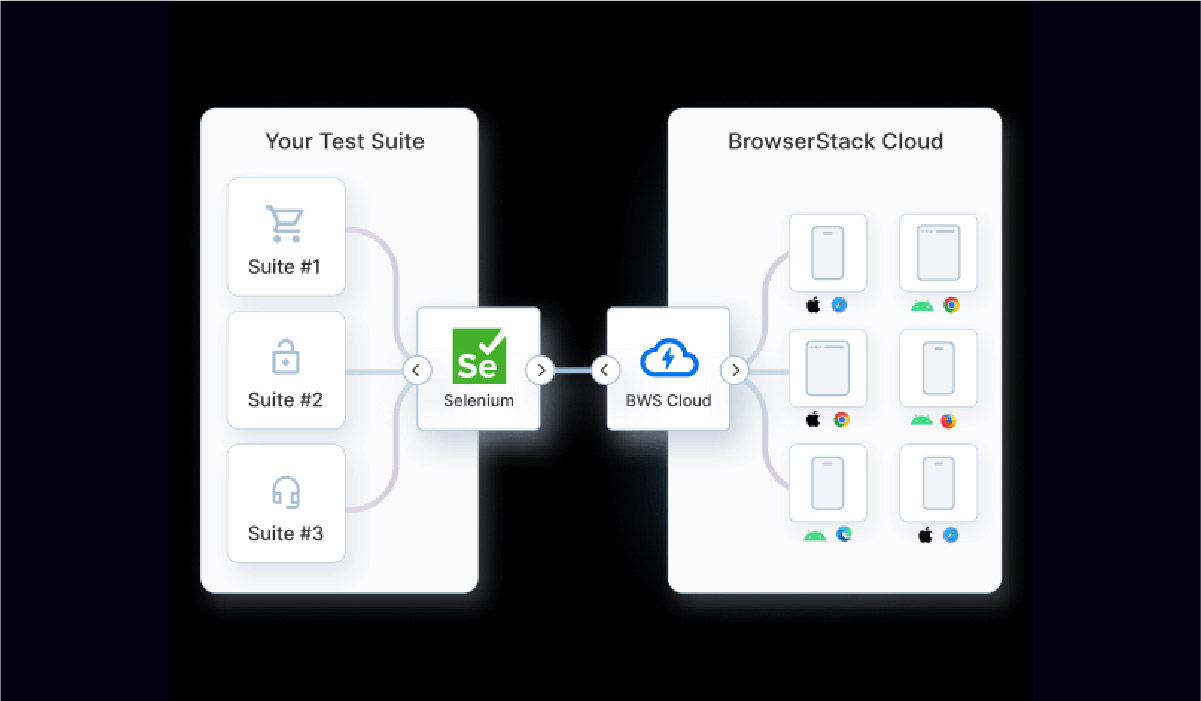The primary goals of software development in today’s DevOps age are continuous development and continuous deployment. Selenium is a popular testing automation framework that enables developers to include continuous testing in their development efforts. It supports a wide range of browsers, platforms, and operating systems.
Smartphone growth has resulted in a diverse variety of devices, platforms, and operating systems in the industry, making mobile-focused applications the latest trend. Organisations must adapt their testing processes to suit mobile application testing. Selenium is the most used tool for testing web applications among testers. It does not natively enable mobile testing; however, it provides frameworks for testing mobile applications.
Selendroid is a Selenium-based mobile testing framework that allows organisations to automate tests on Android devices. However, the choices are restricted here. This is where Appium can help with Selenium mobile testing. Appium is a strong mobile automation testing framework built on Selenium and supports several platforms and technologies.
In this article, we will discuss mobile testing using Selenium and its benefits. We will also cover the types of mobile applications, along with some best strategies for automating different types of mobile applications using Selenium.
Types of Mobile Applications
Mobile applications may be divided into several categories.
Native applications
Native applications are built to work with platform-specific programming languages. It can take advantage of all of the device’s resources and operating system capabilities to provide an excellent application experience to the end user. They can access the camera, GPS, and other built-in features directly. Native applications provide higher speed and stability owing to platform-specific optimisation.
Mobile Web Applications
Web applications, or mobile web applications, are accessible through an internet browser window and do not require storage or installation. These applications function on multiple screen sizes, along with similar features that native applications possess.
Native applications operate offline when disconnected from the internet, but web applications remain inactive under such circumstances. Web applications update themselves on web-hosted servers, eliminating the need for updating them on the device. Both native and web applications have similar features and functionality, but differ in functionality and updates.
Hybrid applications
These applications incorporate characteristics of both native and web applications. They are built with web technologies and packaged in a native container for distribution through app stores. Hybrid applications can operate on many operating systems. This provides them with a cost-effective approach to reach a bigger audience. They can leverage device capabilities via plugins and give a similar user experience to native applications, however, they may not necessarily function in the same way.
Hybrid applications are appropriate for applications that support several platforms without requiring separate codebases. This technique ensures that development efforts are consistent across multiple operating systems, simplifying upgrades and lowering total development costs.
Understanding Mobile Testing Using Selenium
Selenium exists primarily to test web applications, yet it does not provide built-in functionality for mobile application testing. The tool supports mobile testing through its integration with platforms such as Appium that operate IOS and Android applications through the WebDriver protocol. This enables testers to write tests for hybrid and native applications.
Appium connects Selenium and mobile devices. It enables testers to use Selenium WebDriver scripts with the same syntax and principles on mobile applications. This integration offers a uniform testing strategy for efficient and successful Selenium mobile testing across several platforms and devices.
Why use Selenium for automating Hybrid and Native apps
Mobile application testing using Selenium is critical for teams because it enables continuous test automation and regression suites, allowing them to actively offer high-quality digital experiences. Here are a few reasons why Selenium is useful for mobile testing.
Open Source
Selenium is an open-source framework. It serves as a toolkit for automating website and web application testing. The open-source nature of Selenium facilitates free access and modification, through which it establishes a powerful community base with abundant resources.
Appium Integration
Selenium gains its widespread use for mobile testing because it uses Appium as an API extension to WebDriver. Appium serves as a connector between Selenium and mobile testing by enabling the use of the WebDriver protocol together with Selenium’s robust features. Appium enables Selenium to perform testing of native and hybrid applications.
Cross-Platform and Device Support
The Selenium platform with Appium enables testing operations across Android and iOS devices to meet the needs of various mobile applications. Appium includes the ability to conduct testing on Windows desktop applications, thus benefiting applications that operate across different platforms.
Language Support
Applications tested through Selenium and Appium work seamlessly with programming languages such as Python and Java, among multiple others. Testers can select their preferred programming language from the available options due to this flexibility.
Enhanced Automation and Speed
Testing professionals use Selenium to automate manual tasks, which shortens the time needed for testing and lowers associated effort. The implementation of Selenium enables testers to shorten development cycles while simultaneously enhancing the application quality.
Test Coverage
The combination of Selenium with Appium enables testers to conduct a complete evaluation of native, hybrid and mobile web applications. Selenium enables tests for web-based features that exist within native mobile applications.
Community Support and Resources
A strong community of Selenium supporters provides extensive documentation, together with resources and technical help for the tool. The widespread support from Selenium’s community helps users achieve easier learning of the tool alongside better usage and effective problem-solving.
Strategies for Automating Native and Hybrid Applications using Selenium
Here are some strategies for improving automated testing with Selenium mobile testing.
Use Page Object Model
To improve maintainability, structure the code according to the Page Object Model. POM isolates UI components and interactions from test scripts. This entails designing unique classes for each screen or page of the application. Each class has methods for interacting with the components on that page.
This method improves the readability and cleanliness of the code, as well as the speed of updates. If the UI changes, testers can simply need to update the necessary page object class rather than navigating many test scripts.
Employ the desired capabilities effectively
Configure needed capabilities appropriately so that the Appium server understands which platform, device, and application to automate. They contain the platform name, the device name, the application package, and the application activity.
Proper setting of these features guarantees that the tests execute on the relevant device and application version, providing accurate and trustworthy results. Incorrectly configured capabilities might result in failed tests or erroneous results, thus, it is critical to set them up correctly.
Use Appium Inspector and UIAutomatorViewer
These are key tools for analysing mobile application UI elements. These tools assist in determining the attributes and hierarchy of user interface components. This makes it easy for them to create precise locators.
Appium Inspector lets testers interact with elements to learn how they behave. UIAutomatorViewer provides a thorough overview of the UI components and their characteristics. Using these tools makes it much easier to locate elements within complicated applications.
Implement Reliable Locators
Choose secure locators over less stable alternatives such as XPath. Stable locators guarantee that the tests are durable to changes in the user interface. An ID or name property is less likely to change than an XPath expression, which might fail if the UI structure changes.
Using accessibility identifiers enhances both the stability of the tests and the accessibility of the application. Always use unique and static locators to reduce the possibility of failed tests due to UI changes.
Incorporate Mobile Gestures
Automate complicated user interactions to simulate real-world behaviour. Mobile applications frequently use these gestures for navigation and functionality. Through its TouchAction class, Appium provides multiple touch actions that developers can use to simulate gestures during testing operations. Incorporating this set of gestures into testing enables developers to measure application responses that match authentic human interactions. Thus, assuring a more reliable assessment of application behaviour.
Handle context switching
Take care of context switching between native and web views for hybrid applications. Web content is frequently included in hybrid applications inside native application containers. Appium provides context handles for switching between various views. This enables testers to use Appium commands to interact with native elements and Selenium WebDriver commands to interact with web elements.
Context switching must be managed properly to adequately test hybrid applications. Incorrect context switching might result in mistakes while identifying elements and taking actions, which may compromise the accuracy of the testing.
Synchronize tests properly
To handle dynamic elements, use implicit, explicit, and fluent waits, and make sure the tests are resilient to timing issues. Asynchronous operations are commonly used in mobile applications, causing elements to display or change state at separate times. Implicit waits provide a default time for the whole test, but explicit waits require certain requirements to be completed before moving forward.
Fluent waits offer extra flexibility by allowing testers to specify both the waiting condition and the polling frequency. Proper synchronization prevents tests from malfunctioning due to timing concerns. This makes them more credible.
Modularise Test Scripts
Divide tests into reusable methods and functions to increase readability and maintainability. Modularising the test scripts requires creating reusable elements for common behaviours such as logging in, navigation panels, and executing specified tasks.
This method avoids code duplication and makes the tests easier to maintain. If something changes in the application, testers can simply need to update the impacted module rather than the entire test script. Modularisation encourages code reuse and makes it easier to maintain and update the tests.
Use Cloud device platforms
Using a cloud device platform stands as a fundamental requirement to ensure proper performance of mobile applications when operating on multiple devices. These platforms allow testers to select from a variety of real mobiles, tablets, and desktops operating on different platforms such as Android, iOS, Windows, macOS, and more. LambdaTest is one such cloud-based platform.
LambdaTest is an AI-powered test orchestration and execution platform that enables manual and automated testing of hybrid and native mobile applications at scale. The platform enables testers to conduct real-time and automated testing on over 3000 scenarios and real mobile devices. LambdaTest’s cloud device lab has numerous real devices that can be accessed via any browser to run mobile friendly tests. This guarantees a seamless and effective experience for users who visit the website from mobile devices.
The platform employs AI and machine learning to create intelligent locators that self-heal as applications grow. These locators maintain testing stability and reduce maintenance efforts by identifying and adjusting to changes in the application’s user interface elements. It also provides capabilities like automated testing, parallel test execution, and extensive reporting to optimise the testing process and find errors more effectively.
Furthermore, LambdaTest optimised resource allocation using artificial intelligence, which boosts overall test coverage, ensures that tests execute effectively, and reduces test execution time. Its low-code/no-code capabilities make it user-friendly for non-developers while still giving enough versatility for skilled testers. This enables QA teams with different levels of technical competence to be onboarded more quickly.
Conclusion
In conclusion, mastering automated testing for native and hybrid mobile applications with Selenium necessitates a systematic strategy and adherence to best practices. Testers can guarantee complete test coverage by establishing apparent test objectives, utilising the Page Object Model, and deploying dependable locators and mobile gestures. Context switching, appropriate test synchronisation, and test script modularisation all improve test reliability and maintainability.
By integrating with CI/CD pipelines, test execution becomes automated, which helps detect bugs in an early stage. Mobile application developers achieve high-quality software development by implementing these methods and best practices to satisfy users across different devices and operating systems.
For More Information, Visit Megamagazine















